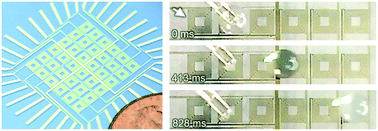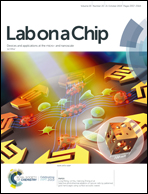Contactless, programmable acoustofluidic manipulation of objects on water†
Abstract
Contact-free manipulation of small objects (e.g., cells, tissues, and droplets) using acoustic waves eliminates physical contact with structures and undesired surface adsorption. Pioneering acoustic-based, contact-free manipulation techniques (e.g., acoustic levitation) enable programmable manipulation but are limited by evaporation, bulky transducers, and inefficient acoustic coupling in air. Herein, we report an acoustofluidic mechanism for the contactless manipulation of small objects on water. A hollow-square-shaped interdigital transducer (IDT) is fabricated on lithium niobate (LiNbO3), immersed in water and used as a sound source to generate acoustic waves and as a micropump to pump fluid in the ±x and ±y orthogonal directions. As a result, objects which float adjacent to the excited IDT can be pushed unidirectionally (horizontally) in ±x and ±y following the directed acoustic wave propagation. A fluidic processor was developed by patterning IDT units in a 6-by-6 array. We demonstrate contactless, programmable manipulation on water of oil droplets and zebrafish larvae. This acoustofluidic-based manipulation opens avenues for the contactless, programmable processing of materials and small biosamples.



 Please wait while we load your content...
Please wait while we load your content...